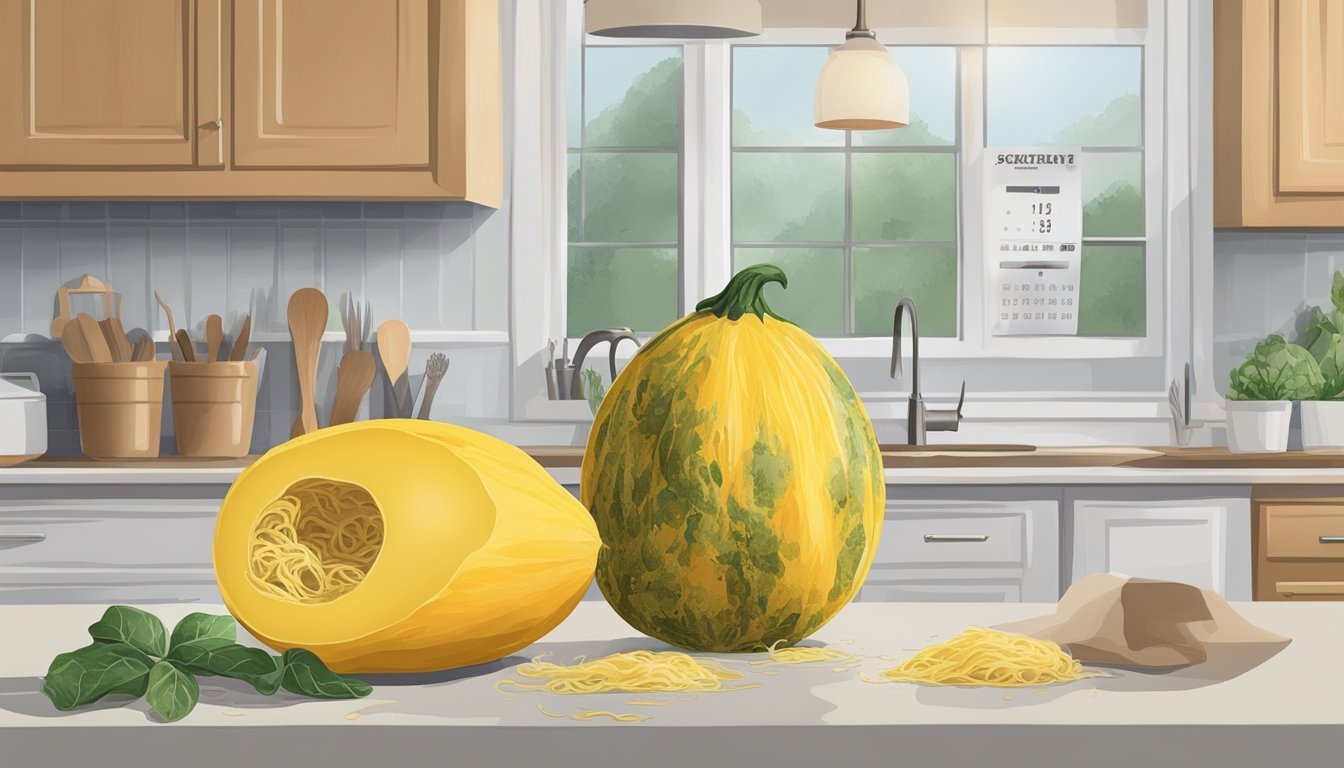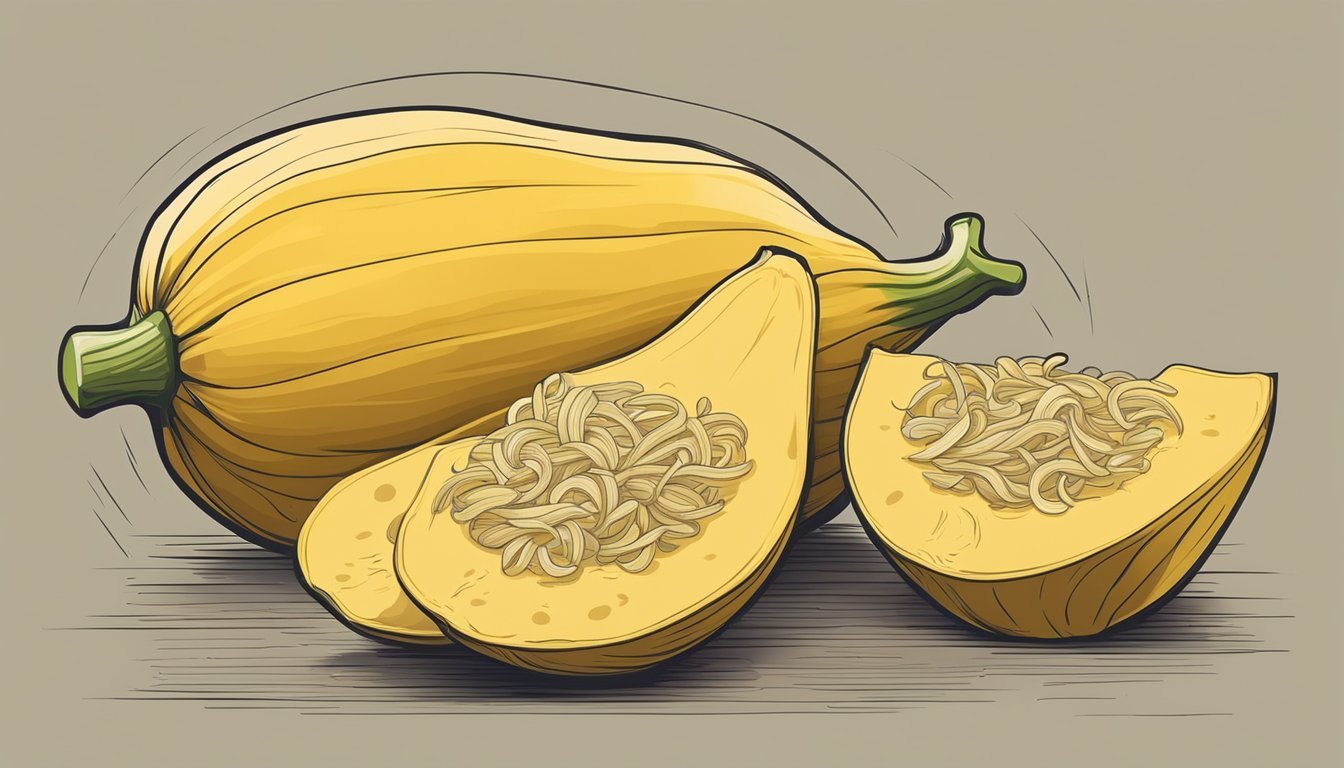Is It Safe to Prepare Expired Spaghetti Squash?
Understanding Food Safety Limits
When it comes to the shelf life of spaghetti squash, it’s essential to know how to determine its freshness and safety for consumption. Spaghetti squash is a nutritious and versatile vegetable that can be stored for an extended period when the right conditions are met. Uncut spaghetti squash can last up to three months in a cool, dry place, such as a pantry or cellar. However, once it's cooked or cut, the clock starts ticking faster, limiting its refrigerated shelf life to about 5 to 7 days.
Proper storage plays a significant role in extending the life of spaghetti squash and ensuring its safety for preparation. Keeping the squash in a refrigerator can preserve its quality for one to two weeks, but only if it shows no signs of spoilage like mold or soft spots. Since the vegetable is hearty, it withstands storage well, but like all food items, there is a point past which it should not be consumed.
Handling expired spaghetti squash correctly is crucial to prevent foodborne illnesses. It's generally not safe to prepare or consume any vegetable that has surpassed its shelf life, developed an off odor, a change in texture, or visible signs of decay. These changes are indicators that the squash could potentially harbor harmful bacteria or fungi. Consumers should inspect their spaghetti squash thoroughly before deciding to cook it, keeping in mind that when in doubt, it's safer to err on the side of caution and discard any questionable produce.
Assessing Spaghetti Squash Freshness
When determining if a spaghetti squash is still safe to prepare, one should conduct a thorough assessment for signs of spoilage. This includes visual inspection, tactile evaluation, and olfactory checks.
Visual Inspection for Spoilage
One should examine the skin of the spaghetti squash for any blemishes or spots. Discoloration or the presence of mold indicates that the squash is no longer fresh. A healthy, ripe spaghetti squash typically has a consistent external color and is devoid of any signs of spoilage.
Evaluating Texture and Firmness
The firmness of a spaghetti squash is a critical indicator of its freshness. A ripe squash should feel solid and heavy for its size, with no soft spots. If the outer shell feels mushy or yields to light pressure, it may be past its prime.
Detecting Changes in Odor
A fresh spaghetti squash should have a subtle, earthy smell. Any unpleasant odor is a telltale sign that the vegetable may have gone bad. Spoiling can affect the flavor, so an off smell suggests that the squash will not taste as it should when prepared.
Proper Storage of Spaghetti Squash
Understanding how to store spaghetti squash properly enhances its lifespan and maintains its quality. Proper storage methods vary depending on if the squash is whole, cut, or cooked.
Storage Conditions for Whole Squash
Whole uncooked spaghetti squash should be kept in a cool, dry place like a pantry. To ensure optimal freshness, store it at room temperature away from direct sunlight and high humidity. These conditions help maintain the squash's integrity for up to three months.
Refrigeration of Cut Squash
Once cut, spaghetti squash should be stored in the refrigerator. To prevent dehydration and spoilage, cover the cut surface with plastic wrap or place the squash in an airtight container. In the fridge, cut spaghetti squash can last for about one to two weeks. Regularly inspect the squash for any signs of spoilage, such as mold or an off smell.
Freezing Cooked Spaghetti Squash
To freeze cooked spaghetti squash, ensure it has cooled completely before placing it into freezer-safe bags or an airtight container. It's crucial to remove as much air as possible to prevent freezer burn. In the freezer, cooked spaghetti squash can maintain its quality for several months. When ready to use, thaw the squash in the refrigerator or reheat it directly from the freezer.
Health and Nutrition Information
Spaghetti squash is esteemed for its versatility in the kitchen and impressive nutrient profile. This vegetable offers a medley of vitamins and minerals while being a fitting alternative for those monitoring carbohydrate intake.
Benefits of Consuming Spaghetti Squash
Spaghetti squash is a nutrient-dense vegetable known for being a low-calorie and low-carb alternative to traditional pasta. One cup of cooked spaghetti squash contains approximately 42 calories and 10 grams of carbohydrates which is significantly lower than its wheat-based counterpart. Notable for its content in vitamin C and manganese, it contributes to the body’s ability to protect against oxidative stress and inflammation. Additionally, spaghetti squash offers a decent amount of dietary fiber, promoting digestive health.
Nutrition Profile per 1 Cup (155g):
Calories: 42
Carbohydrates: 10g
Dietary Fiber: 2.2g
Vitamin A: 5.4% of the Daily Value (DV)
Vitamin C: 8.5% of the DV
Manganese: 8% of the DV
Potassium: 108mg
Dietary Considerations
Individuals seeking a healthy alternative to refined grains may find spaghetti squash to be a valuable addition to their diet. Its low-calorie and low-carbohydrate profile suits a variety of dietary needs, including those of people with diabetes or those following a weight management plan. The presence of potassium and fiber in spaghetti squash supports cardiovascular health and can play a role in maintaining a healthy blood pressure. Since spaghetti squash is a whole food, it aligns well with plant-based and whole-food diets, adding a versatile veggie option that can be incorporated into numerous meals.
Cooking and Preparing Spaghetti Squash
To ensure that spaghetti squash is prepared safely and deliciously, proper cooking, cutting, and serving techniques must be adhered to. These steps will help retain the vegetable's texture and flavor while incorporating it into a variety of dishes.
Basic Cooking Instructions
Spaghetti squash can be cooked using multiple methods, ensuring that the flesh becomes tender without being mushy. Baking is a popular method; preheat the oven to 400 degrees Fahrenheit, slice the squash in half lengthwise, and remove the seeds. A drizzle of olive oil and a sprinkle of salt and pepper can enhance flavor. Place the halves cut-side down on a baking sheet and cook until tender, typically for about 40 to 60 minutes. Microwaving is a quicker alternative; after cutting and seeding, place the squash halves cut-side down on a microwave-safe dish and cook for 10-15 minutes, or until tender.
Cutting and Handling Techniques
When preparing a spaghetti squash, use a stable surface and a sharp knife to carefully cut the squash in half from top to bottom. A thick exterior makes cutting tricky, so proceed with caution to avoid slipping. Once opened, use a large spoon to scoop out the seeds and the stringy bits of pulp. The cleaned halves of spaghetti squash are now ready for cooking or can be stored properly before use.
Serving Suggestions and Recipes
Once cooked and still warm, the spaghetti squash can be served in various ways. One can gently fluff and separate the tender strands with a fork to create a spaghetti-like texture. Serving suggestions include topping the squash with marinara sauce and a sprinkle of parmesan cheese for a classic touch. For a more creative option, consider incorporating it into stir-fries, or use it as a base for a spaghetti squash recipe featuring pesto or other flavorful sauces. The neutral taste of spaghetti squash makes it a versatile component in many dishes.
Food Safety Considerations
When it comes to expired spaghetti squash, assessing the risk of spoilage and understanding safe procedures for consumption are critical for preventing foodborne illness. The reader should be aware that consuming spoiled food can be dangerous, and proper handling is essential for safety.
Understanding Spoilage and Risk
Spaghetti squash is subject to spoilage like any fresh produce. Indicators of spoilage include:
Soft spots: They often precede more severe rotting.
Discoloration: A change from its natural yellow to a dark or brown color.
Unpleasant odor: A sour or off smell is a strong indicator of spoilage.
Mold growth: Visible mold is a clear sign that spaghetti squash is no longer safe to eat.
Spoilage is a biological process that can put consumers at risk if the product is ingested. Mold growth in particular is a significant risk factor as it produces mycotoxins that can be harmful when eaten. It is vital to evaluate the quality and ripeness of spaghetti squash before preparation to avoid the risks associated with consuming bad squash.
Procedures for Safe Consumption
Inspecting the squash:
Examine the outer skin for indications of spoilage.
Check the firmness - it should be hard.
Sniff for any odors that seem off-putting.
Preparation:
Cooked spaghetti squash: Ensure it is heated thoroughly, as reheating to a sufficient temperature can kill bacteria but not necessarily neutralize all toxins already produced by spoilage.
Serving: Only serve cooked spaghetti squash that has been properly stored and shows no signs of spoilage.
When opting to consume spaghetti squash that is nearing or has passed its expiration date, it is crucial to act with an abundance of caution. One should never consume spaghetti squash if there are any doubts about its safety. Any signs of spoilage, especially if the squash exhibits mold or an unpleasant smell, dictate that it should not be eaten to prevent potential foodborne illnesses.
Selecting and Buying Quality Squash
When purchasing spaghetti squash, one should look for firm, heavy vegetables with an intact rind. The right selection promises a good shelf life and ensures the squash is safe to prepare even as it approaches its expiration date.
Choosing the Best Squash at the Store
To pick the best store spaghetti squash, consider these specific qualities:
Weight: A quality squash feels heavy for its size, indicating sufficient moisture content.
Rind: The rind should be hard and intact without any cracks or soft spots.
Appearance: Look for a squash with a dull sheen, which suggests it's ripe.
Stem: A dry, intact stem signifies a squash that was harvested at the right time.
Identifying Types of Winter Squash
Winter squash comes in various types, each suited for different culinary uses:
Spaghetti Squash: Often labeled as vegetable spaghetti or noodle squash, this variety is characterized by its unique flesh that separates into spaghetti-like strands when cooked.
Butternut Squash: A different winter squash, recognizable by its tan-yellow skin and bell shape, prized for its sweet, nutty flavor.
When selecting any type of winter squash at the grocery store, apply similar criteria mentioned above to determine its quality and freshness.
Shelf Life and Spoilage Prevention
When it comes to spaghetti squash, understanding its shelf life and how to prevent spoilage is key to maintaining freshness and safety in consumption.
Extended Storage Techniques
Spaghetti squash can last up to three months when uncut and stored in a cool, dry place such as a pantry or root cellar. For optimal conditions, the temperature should be relatively stable, ideally between 50 to 60 degrees Fahrenheit. Refrigeration can extend the squash's life by one to two weeks, and this method is recommended during warmer seasons. Alternative methods to further prolong shelf life include:
Wrapping: Enclosing spaghetti squash in plastic wrap can help retain moisture and prevent drying out.
Inspection: Regular checks for bruises or soft spots can help in using the squash before it goes bad.
Signs that Squash Has Gone Bad
Spaghetti squash exhibits clear signs when it is no longer safe to eat. Here are the signs to watch for:
Visual Indicators:
The presence of bruises or other forms of discoloration.
A surface that has become soft and yields to pressure with ease.
Textural Changes:
A once firm flesh that has turned stringy or slimy, indicating decomposition.
Odor:
An unpleasant odor that departs from the squash's typically mild, slightly sweet scent.
To ensure safety, it is recommended to discard spaghetti squash if any of these indicators are present.









